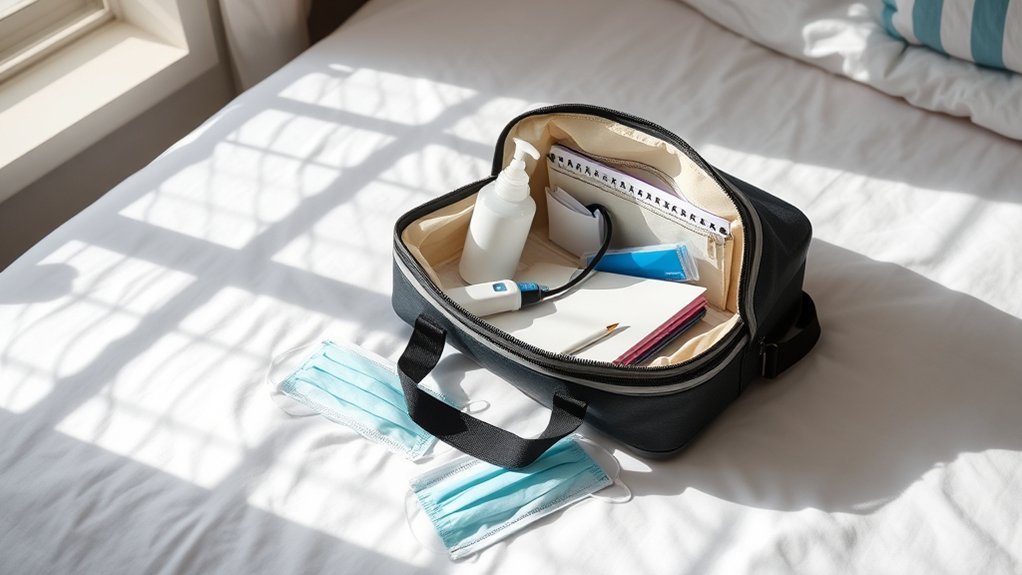You might think you have plenty of time before labor starts, but being prepared is essential. Recognizing the signs of impending labor can make a significant difference in your experience. Regular contractions, changes in discharge, and pelvic pressure are just a few indicators. Understanding these symptoms will help you know when it’s time to pack your hospital bag and head to the hospital. Let’s explore what to look for as labor approaches.
Understanding Labor: What to Expect

As you approach labor, understanding what to expect can help ease anxiety and prepare you for the experience.
Labor typically unfolds in three stages: early labor, active labor, and shift. During early labor, you may experience mild contractions and some cervical dilation. This phase can last several hours or even days.
Active labor involves stronger contractions occurring more frequently, leading to significant dilation of the cervix.
Shift, the most intense stage, is characterized by rapid dilation and frequent contractions.
It’s essential to monitor your physical and emotional state during these stages. Stay hydrated, practice relaxation techniques, and communicate with your healthcare provider.
Being informed about these stages equips you to recognize when it’s time to head to the hospital and guarantees a smoother labor experience.
Recognizing Contractions: Timing and Intensity

To recognize contractions effectively, you’ll need to identify their types and how they change over time.
Start by monitoring the timing and intensity of each contraction, noting their frequency and duration. This information is essential for determining your progression in labor and when it’s time to head to the hospital.
Types of Contractions
Recognizing the types of contractions you experience during labor is essential for understanding your body’s signals.
There are primarily three types: Braxton Hicks contractions, true labor contractions, and pivotal contractions.
Braxton Hicks, often referred to as practice contractions, are irregular and usually painless, signaling your body’s preparation for labor.
True labor contractions occur at regular intervals, increasing in intensity and duration; they indicate that labor has begun.
Pivotal contractions happen during the transition phase, characterized by increased intensity and frequency, often leading to the urge to push.
Identifying these contractions helps you distinguish between early labor and active labor stages, guiding your decision on when to head to the hospital.
Being aware of these differences is essential for managing your labor experience effectively.
Monitoring Contraction Patterns
Monitoring contraction patterns is vital for evaluating your labor progress and determining when to seek medical assistance. Start by timing the frequency of your contractions—note how long they last and the intervals between them.
A contraction typically lasts 30 to 60 seconds, with early labor contractions occurring every 5 to 30 minutes. As labor progresses, they may become more intense, lasting longer, and occurring closer together.
Pay attention to the intensity; if contractions become stronger and more painful, it’s a sign labor is advancing. It’s important to communicate this information to your healthcare provider, as they’ll use it to assess your labor stage and make recommendations.
Stay attentive to these patterns to guarantee a safe delivery experience.
The Importance of Water Breaking

When your water breaks, it signifies a critical stage in labor, often indicating that delivery is imminent. This event, medically known as rupture of membranes, can happen before contractions begin or during labor. Understanding its significance helps you prepare for the next steps.
| Aspect | Details |
|---|---|
| Timing | Can occur before or during labor |
| Fluid Color | Should be clear; yellow or green may indicate issues |
| What to Do | Contact your healthcare provider immediately |
Recognizing the importance of water breaking allows for timely medical intervention, ensuring both your safety and your baby’s well-being. Stay alert and informed, as this moment is essential in your birthing process.
Signs of Pre-Labor: When to Start Packing
How can you tell when it’s time to start packing your hospital bag? Pay attention to certain signs of pre-labor.
One key indicator is the onset of regular contractions, which may start as mild and increase in intensity and frequency. You might also notice changes in vaginal discharge, such as increased mucus or a blood-tinged show, signaling that your body is preparing for labor.
Additionally, if you experience a sudden burst of energy, often referred to as “nesting,” it may be a sign that labor is approaching.
Keep track of any significant changes in your body and don’t hesitate to consult your healthcare provider for guidance. When these signs appear, it’s time to finalize your hospital bag.
Other Symptoms: Back Pain and Pressure
As you approach labor, back pain and pressure can signal important changes in your body.
Back pain may arise from hormonal shifts, the baby’s positioning, or the strain of carrying extra weight.
Recognizing signs of pressure in your pelvis is vital, as it can indicate the progression toward delivery.
Causes of Back Pain
Back pain can stem from various causes, and understanding these underlying issues is essential for effective management.
You might experience back pain due to:
- Muscle strain: Overexertion or improper lifting can lead to muscle or ligament strains.
- Herniated discs: Discs that cushion your vertebrae may bulge or rupture, pressing on nerves.
- Arthritis: Inflammation in the spine can cause pain and stiffness, often worsening with age.
Recognizing these causes can help you address your back pain more effectively.
Recognizing Pressure Signs
Recognizing pressure signs is essential, especially when they accompany back pain, as these symptoms can indicate more serious underlying issues.
You should be aware of sensations like increased tightness or heaviness in your abdomen or pelvis. If you experience consistent pressure in these areas, it may signify potential complications, such as preterm labor or other obstetric emergencies.
Pay close attention if this pressure is accompanied by changes in your back pain intensity or location, as this may further warrant medical evaluation.
Don’t ignore any other unusual symptoms, including vaginal discharge, bleeding, or cramping. Monitoring these signs closely will help you communicate effectively with your healthcare provider, ensuring timely intervention when necessary.
Always prioritize your health and seek assistance when in doubt.
Emotional and Physical Changes as Labor Approaches
When labor approaches, you’ll likely experience a range of emotional and physical changes that signal your body is preparing for delivery.
These changes can be both intense and unsettling but are entirely normal.
- Emotional Fluctuations: You may feel heightened anxiety or excitement as you anticipate the arrival of your baby.
- Physical Discomfort: Increased pelvic pressure and back pain can occur as your body adjusts for labor.
- Fatigue: You might find yourself feeling more tired than usual, as your body uses energy to prepare for childbirth.
Recognizing these signs can help you better understand what to expect, allowing you to focus on your upcoming labor and delivery more effectively.
Preparing Your Hospital Bag: Essential Items
Packing your hospital bag well in advance can make a significant difference when labor begins. Start with essential documents like your ID, insurance information, and birth plan.
Packing your hospital bag ahead of time is crucial for a smooth labor experience. Don’t forget your essential documents!
For personal comfort, include items such as a soft robe, non-slip socks, and toiletries like toothbrush and shampoo. Don’t forget your phone charger and a list of contacts.
If you’re planning to breastfeed, pack a nursing pillow and comfortable bras. For the baby, include a going-home outfit, diapers, and a blanket.
Also, consider snacks and water for your partner. Keeping all items organized in a dedicated bag will help you remain focused and prepared as you head to the hospital.
Final Checklist Before Heading to the Hospital
A final checklist can assure you’re fully prepared for your hospital visit. Before heading out, verify you have everything necessary for a smooth experience. Check the following items:
- Identification and Insurance Information: Bring your ID, insurance card, and any relevant medical paperwork.
- Comfort Items: Pack personal comfort items like a favorite blanket, pillow, or reading material to help ease anxiety.
- Essentials for Baby (if applicable): Include a going-home outfit, baby blanket, and any necessary baby gear.
Double-check that your hospital bag is packed and your vehicle is ready for the journey.
Also, confirm you have a reliable means of transportation. With this checklist, you’ll minimize stress and focus on what’s important—your health and well-being.
Frequently Asked Questions
What Should I Include for My Partner in the Hospital Bag?
Include essential items like comfortable clothing, toiletries, snacks, a phone charger, and a camera. Don’t forget their favorite pillow, a water bottle, and any necessary medications to guarantee they feel supported and comfortable during your stay.
Can I Pack Snacks for Myself During Labor?
Of course, you can pack snacks for yourself during labor—because who doesn’t want a gourmet buffet while bringing a new human into the world? Just be mindful of your hospital’s food policies and your comfort.
How Early Can I Start Packing My Hospital Bag?
You can start packing your hospital bag around 34 to 36 weeks of pregnancy. This gives you ample time to gather essentials without the stress of last-minute preparations as your due date approaches.
What if My Water Breaks at Night?
If your water breaks at night, stay calm. Monitor contractions, time them, and head to the hospital when they’re regular. Don’t hesitate to call your healthcare provider for guidance based on your specific situation.
Should I Bring My Own Pillows or Blankets?
You should definitely bring your own pillows and blankets if you prefer them for comfort. Familiar items can enhance your relaxation, which is vital during your hospital stay. Just make sure they’re easily washable.
Conclusion
In conclusion, being aware of the signs and symptoms of impending labor is essential for expectant parents. Just as a storm gathers intensity before breaking, your body will exhibit clear signals that it’s time to head to the hospital. By preparing your hospital bag ahead of time, you can alleviate stress and guarantee you have everything you need for this significant moment. Stay attentive to your body, and trust your instincts as labor approaches.
